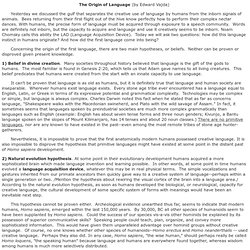

110329-VOXY-HARDLANGUAGES-FINAL-WIDE.png (860×3034) 16 Old-Timey Slang Terms to Describe Being Drunk. 8 Countries With Fascinating Baby Naming Laws. Here in the U.S., you can name your kid almost anything, but that's not the case everywhere in the world. Let's take a look at some countries with pretty strict or otherwise fascinating baby-naming laws. 1. Germany In Germany, you must be able to tell the gender of the child by the first name, and the name chosen must not be negatively affect the well being of the child. Also, you can not use last names or the names of objects or products as first names. Rejected names: Matti was rejected for a boy because it didn't indicate gender. 2. Enacted in 1982, the Naming law in Sweden was originally created to prevent non-noble families from giving their children noble names, but a few changes to the law have been made since then.
Rejected names: "Brfxxccxxmnpcccclllmmnprxvclmnckssqlbb11116" (pronounced Albin, naturally) was submitted by a child's parents in protest of the Naming law. Also rejected: Metallica, Superman, Veranda, Ikea, and Elvis. 3. Rejected names: Akuma, meaning "devil. " Shakespeare Insult Kit. Shakespeare Insult Kit Since 1996, the origin of this kit was listed as anonymous.

It came to me on a piece of paper in the 90's with no attribution, and I thought it would make a cool web page. Though I searched for the origin, I could never find it. In 2014, Lara M informed found the originating author. It appears to be an English teacher at Center Grove High School in Greenwood Indiana named Jerry Maguire. Combine one word from each of the three columns below, prefaced with "Thou": My additions: cullionly whoreson knave fusty malmsey-nosed blind-worm caluminous rampallian popinjay wimpled lily-livered scullian burly-boned scurvy-valiant jolt-head misbegotten brazen-faced malcontent odiferous unwash'd devil-monk poisonous bunch-back'd toad fishified leaden-footed rascal Wart-necked muddy-mettled Basket-Cockle pigeon-liver'd scale-sided Back to the insulter.
Linguistics 201: The Origin of Language. The Origin of Language (by Edward Vajda) Yesterday we discussed the gulf that separates the creative use of language by humans from the inborn signals of animals.

Bees returning from their first flight out of the hive know perfectly how to perform their complex nectar dances. With humans, the precise form of language must be acquired through exposure to a speech community. Words are definitely not inborn, but the capacity to acquire and language and use it creatively seems to be inborn. Noam Chomsky calls this ability the LAD (Language Acquisition Device).
Concerning the origin of the first language, there are two main hypotheses, or beliefs. 1) Belief in divine creation. It can't be proven that language is as old as humans, but it is definitely true that language and human society are inseparable. Nevertheless, it is impossible to prove that the first anatomically modern humans possessed creative language. 2) Natural evolution hypothesis. Behind the Name: the Meaning, Etymology and History of First Names.
Foreign Language Teaching Methods: Vocabulary. Actively Teaching Vocabulary Vocabulary is a necessary ingredient for all communication.

Language learners encounter vocabulary on a daily basis, and must be able to acquire and retain it. As a language teacher, one of your main tasks is to help students develop a rich and useful vocabulary inventory. Nation (2001) emphasizes that learning vocabulary is a cumulative process and that it must be deliberately taught, learned, and recycled. This is critical for several reasons: Learners need to encounter the words in a variety of rich contexts, often requiring up to sixteen encounters. Repeated Encounters with the Same Word Students need to encounter vocabulary in various contexts in order to remember it and to develop an understanding of the range of usage of a given word. With this in mind, let's watch the video to glean a better understanding of learners' needs and why teaching vocabulary plays such an important role.
English language did you knows. Aramaic language. This article is about the Semitic language now spoken by smaller numbers of people in scattered locations.

For the Semitic language spoken in Ethiopia, see Amharic. Aramaic (Arāmāyā, Classical Syriac: ܐܪܡܝܐ) is a family of languages or dialects belonging to the Semitic family. More specifically, it is part of the Northwest Semitic subfamily, which also includes Canaanite languages such as Hebrew and Phoenician. The Aramaic script was widely adopted for other languages and is ancestral to both the Arabic and modern Hebrew alphabets. During its approximately 3000 years of written history,[2] Aramaic has served variously as a language of administration of empires and as a language of divine worship. Aramaic's long history and diverse and widespread use has led to the development of many divergent varieties, which are sometimes considered dialects, though they are distinct enough that they are sometimes considered languages.
Etymology[edit] Geographic distribution[edit] Writing system[edit]